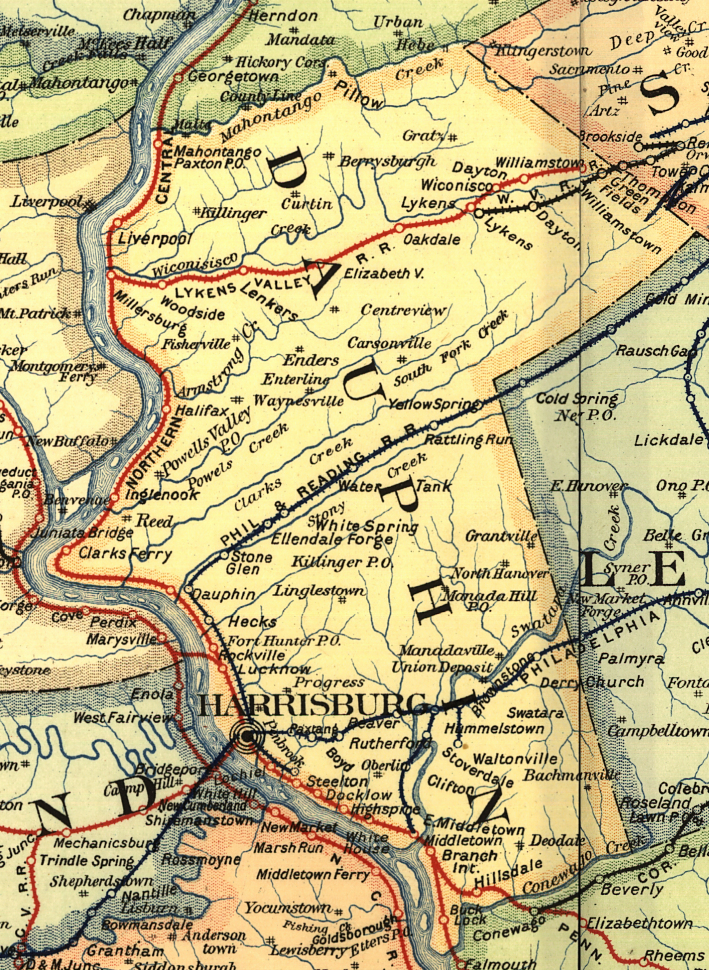Well this is what I found in an old Pennsylvania Magazine from March 1987.
The original Lykens Valley Railroad was first constructed around 1834. It was used to haul coal to the Wiconisco Canal in Millersburg, and from there to the Pennsylvania Canal. The PRR owned collieries in Wiconisco in the late 1800's, as did the RDG. The RDG came over the mountains to the east via Pine Grove, Tremont and Tower City - while the PRR used the LVRR to haul the coal from Lykens/Wiconisco and Williamstown to the Northern Central RR in Millersburg, which by this time ran from Harrisburg to Sunbury on the east shore of the Susquehanna River. There are three railroad right of ways on the Broad Mountain from Wiconisco east to Williamstown and on to Tower City.
The Lykens Valley Railroad was built sixteen miles, from Bear Creek Gap to the Susquehanna, and was in operation in 1834, transporting the coal by horse-power over the flat strap-rail. The cars were carried across the Susquehanna on "arks", the coal dumped into chutes on the canal, loaded on the canal boats and transported to the various markets. This was the fourth railroad in the country and the first in Dauphin county, to transport anthracite coal. "The first canal boat load of Lykens Valley coals, now so famous, was sent April 19, 1834, by Boat No. 76, forty-three tons
In 1856 the Pennsylvania Railroad Company took control of the line and replaced the rail with t-rail. In 1856 the Susquehanna Division of the Northern Central Railway completed a line from Dauphin to Millersburg which meant that coal would be shipped by rail instead of boat.
The Summit Branch Railroad was built in 1866 from a point near Lykens to the Williamstown Colliery. The Lykens Valley Railroad extended to Williamstown and was leased to the Summit Branch Railroad. It was operated until 1880 when it was placed in the hands of the Northern Central Railway. The railroad branched in to freight and passenger service. In 1928 the steam train to Harrisburg was replaced by a gasoline-electric train. Passenger service was discontinued in 1937.
In the 1970's the tracks were torn up from Lykens to just before Elizabethville. Then the tracks were eventually torn up from Elizabethville down to Millersburg.

This is copied from this book; American Railroad Manual for the United States
SUMMIT BRANCH RAILROAD COMPANY.
This company was practically incorporated to operate the Lykens Valley Railroad, running from Millersburg to Williamstown, a distance of 20 miles. The only portion of road owned by the Summit Branch Railroad Company is a short line, Six mile long, from Summit mines to a junction with the Lykens Valley Railroad. The capital stock authorized by law is $2,750,000, of which $2,502,250 have been subscribed and actually paid in. There is also a funded debt, 6 per cent, first mortgage bonds, maturing July 1, 1875, $145,000; and the total liabilities of the company, as represented by stock and debt, are $2,647,250. The cost of road and equipment, including Lykens Valley Railroad lease, is quoted as $988,902.37, and in addition the company owns real estate valued at $1,500,000; so that the total value of properly may be estimated as $2,488,902.37. The company owns 7 locomotives, 2 passenger cars, and 5 baggage, mail, and express cars ; and the cars for the transportation of coal are furnished by the parties operating the mines and by the Northern Central Railway Company. Earnings for fiscal year ending November 30, 1872, amounted to $322,986, derived from the following sources : from passengers, $8279.34; from freight, $291,458.44; from miscellaneous sources, $23,248.22. Expenses for the same period were $76,040.43, distributed as follows: for maintenance of way and structures, $27,336.76; for locomotive repairs, $5,853.31; for car repairs, $896; for conducting transportation, $38,682.05; for general expenses, $3272.31. Net earnings were $246,945.57, out of which was paid rental dividends at the rate of 6 per cent, upon the share capital, interest on the bonds and taxes.
LYKENS VALLEY RAILROAD COMPANY.
This company built a road from Millersburg to Williamstown, a distance of 20 miles, and in April, 1866, leased its property to the Summit Branch Railroad Company, with the understanding that the lessees should pay as rental (free from all taxes and assessments other than the United States income tax) $62,500. It was also provided that any improvements made upon the leased property by the lessees during the continuance of the lease should be deemed and considered the property of the lessors, without compensation therefor to the lessees. During the past six years the lessees have made considerable permanent improvements and additions to the property, so that the present cost of construction and value of the road is considerably in excess of what it was when the lease was made. The capital stock of the Lykens Valley Railroad Company is returned as $600,000, on which 10 per cent, dividends in quarterly payments are regularly declared.
Hope this helps,
Len.







